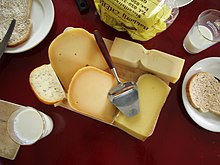Healthy eating habits/Menopause: The Importance of Calcium
Leora Sifris
Every woman will at some point in her life reach menopause, the cessation of the menstrual cycle. During menopause there is a gradual decline in the hormone oestrogen, which results in changes in body composition. It is particularly important to maintain your bone health as your body begins to change. During menopause, what you eat influences how your body manages the changes experienced during and post menopause. It is therefore important to understand role good nutrition plays during this stage of the lifespan, in particular the role of calcium in maintaining strong bones and teeth.

What is calcium and why is it so important?[edit | edit source]
Calcium is a mineral found in many foods, in particular dairy products. Almost all of the calcium we consume is stored in our bones and teeth. Calcium plays many important roles in the body. Calcium is needed by the body to strengthen bones and teeth. It is also important in regulating muscle function, regulating heart function and helps nerves to carry messages between the brain and other parts of the body.
Who needs calcium?[edit | edit source]
Calcium is not only important for growing children, but also essential for teenagers and especially older females.
Menopausal women[edit | edit source]
As we age, calcium absorption decreases and our bones begin to lose calcium. Women in particular lose more calcium from their bones during the 5-10 years around menopause. Postmenopausal women have a reduced ability to absorb calcium. The hormone oestrogen is responsible for the absorption of calcium. Following menopause there is reduction in oestrogen, which results in reduced bone mineralisation – reduced calcium stored in the bones. Unfortunately, it is not possible to reverse losses of calcium. However, sufficient intake of calcium in the diet may slow the weakening of bones.
Where is calcium found?[edit | edit source]




There are many dietary sources of calcium. The main source of calcium among Australians is dairy products. Other good sources of calcium include:
- Green leafy vegetables
- Nuts and seeds
- Fish
- Calcium fortified foods
Food sources of calcium[edit | edit source]
Dairy sources
- Milk and milk products
- Yoghut
- Cheese
- Ice cream
- Custard
Green leafy vegetables
- Broccoli
- Spinach
- Bok choy
- Kale
- Cabbage
Canned Fish
- Salmon
- Sardines
Nuts and Seeds
- Almonds
- Brazil nuts
How much calcium do I need?[edit | edit source]
See table below
Females
| Age (years) | Serves per day |
|---|---|
| 19-50 | 2.5 |
| 51+ | 4 |
What is a serve of calcium?[edit | edit source]
According to the Australian Guide to Healthy Eating one serve of calcium is equivalent to:
Dairy products
- 1 cup (250ml) of milk (includes ready to drink, UHT long life, soy and rice milk)
- 3/4 cup (200g) of yoghurt
- 2 slices (40g) of hard cheese e.g. cheddar
- 1/2 cup (120g) of ricotta cheese
It is important to remember to choose low fat dairy products whenever possible. The calcium content does not change, however the fat and total energy (kilojoule/calorie) intake does. Other dairy products such as custard and ice cream are a good source of calcium, but they are higher in saturated fat and added sugar and therefore classified as 'sometimes' food choices.
Non dairy sources of calcium
Green leafy vegetables
- 2 cups of broccoli
- 6+ cups of spinach
Although spinach contains high amounts of calcium, only approximately 5% is absorbed. This does not occur with broccoli and other green leafy vegetables. Although green leafy vegetables are a good source of calcium, they are not as calcium rich as dairy products and fish with bones.
Fish
- 75-80g of salmon (canned with bones eaten)
- 45g of sardines (canned in water)
Remember to consume the bones, as this is where the calcium is stored
Nuts
- 1/2 cup (100g) of almonds
What happens if I don't have enough calcium?[edit | edit source]
If there is not enough calcium in the blood, your body will take calcium from your bones. If calcium intake is consistently inadequate, the calcium stores in the bones become depleted. This causes bones to become weak and brittle, increasing the risk of fractures and osteoporosis. Eating plenty of calcium rich foods and exercising regularly helps to delay the weakening of bones.
I have heard there are some foods that increase calcium excretion. Is this true?[edit | edit source]
Yes. Excessive amounts of alcohol, caffeine, salt, soft drinks and smoking may increase the amount of calcium lost from the body in urine.
Additional Resources[edit | edit source]
Osteoporosis Australia http://www.osteoporosis.org.au
Australian Dietary Guidelines 2013 http://www.eatforhealth.gov.au
Dairy Australia http://www.dairyaustralia.com.au/Health-and-nutrition.aspx
References[edit | edit source]
1. Better Health Channel. (2013). Calcium. Retrieved from http://www.betterhealth.vic.gov.au/bhcv2/bhcarticles.nsf/pages/Calcium
2. Brown, A. (2011). Understanding Food: Principles & Preparation (4th ed.), Belmont, CA: Wadsworth, Cengage Learning.
3. National Health and Medical Research Council (2013) Australian Dietary Guidelines. Canberra: National Health and Medical Research Council. Retrieved from http://www.nhmrc.gov.au/_files_nhmrc/publications/attachments/n55_australian_dietary_guidelines_130530.pdf
4. National Osteoporosis Foundation. (n.d.). Food and Your Bones: More Tips For Eating For Good Bone Health. Retrieved from http://www.nof.org/foods
5. Osteoporosis Australia. (2013). Calcium. Retrieved from http://www.osteoporosis.org.au/
6. Whitney, E., Rolfes, S., Crowe, T., Cameron-Smith, D. & Walsh, A. (2011). Understanding Nutrition: Australian and New Zealand Edition. South Melbourne: Cengage Learning.